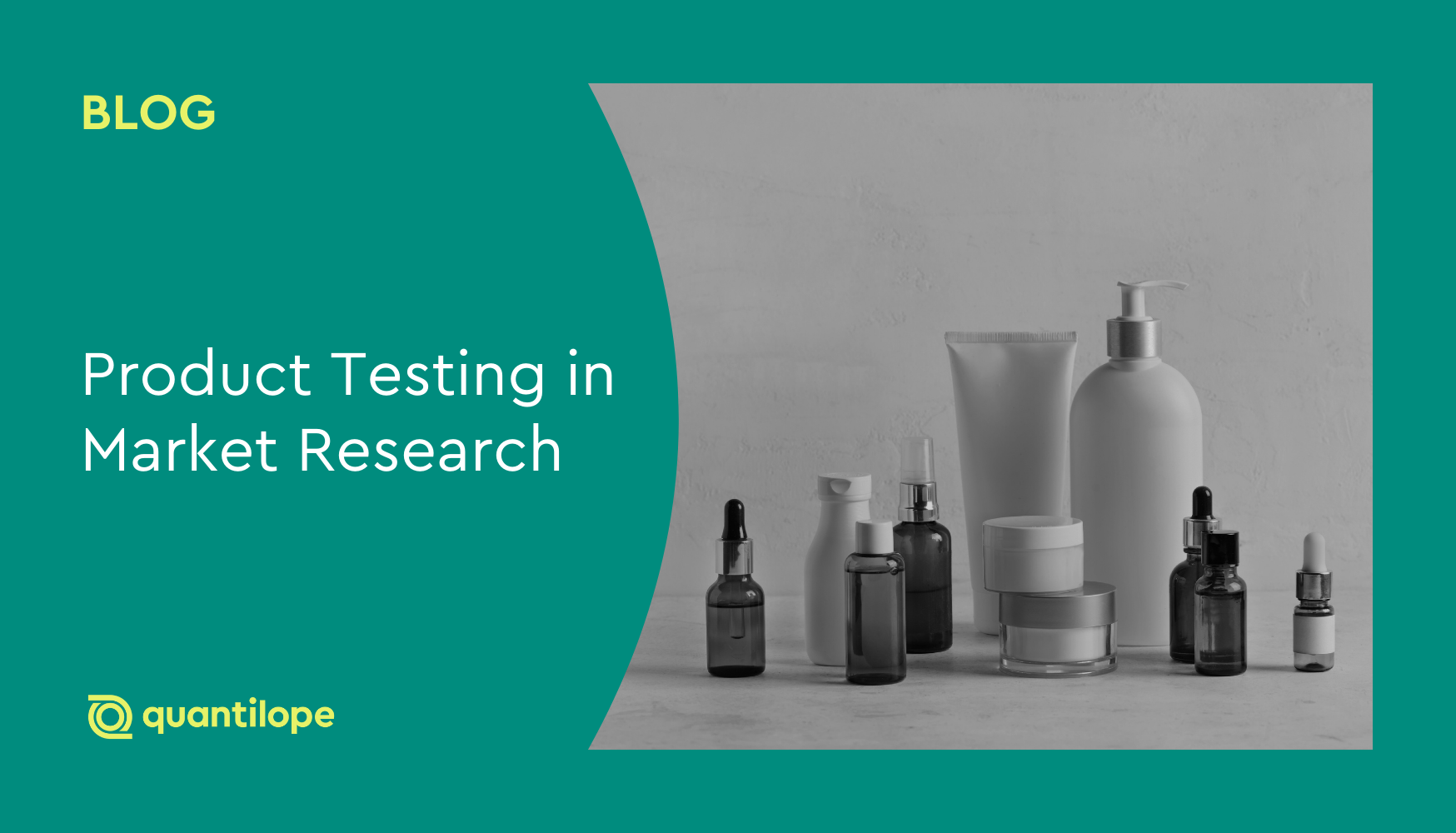A key part of knowing your brand’s category means understanding the consumer landscape in which it sits. In this blog, we look at how category insights provide numerous benefits for your brand and category management.
Table of Contents:
- What are category insights?
- Why category insights are important
- How to conduct a category insights study
- How to use category insights for business growth
- How fast can you conduct a category insights study?
- How to use quantilope for a quick-turn category insights study
- What should be in a final category insights report?
- Example of a category insights report
- Run your category insights study easily with quantilope!
What are category insights?
Category insights are pieces of knowledge that allow brands to develop a deeper understanding of the dynamics and relationships between other brands in their product/service category, as well as how the category serves its consumers. These insights ultimately help brands drive their decision-making to put them in the best positions possible.
A product/service category is how consumers group brands in their mind - like Cheerios and Frosted Flakes as cereals, or Allstate and State Farm as insurance providers. Products within a category are often placed together on the shelf - but not always. Consider the ‘drinks’ category for example. You wouldn’t typically find sports drinks and water next to milk or beer products. That’s because, within a product or service category, there will likely be sub-categories, making category insights all the more important to define and understand within each niche market.
As another example, let’s say you’re in charge of a flavored sparkling water brand. Category insights will tell you the specific sub-category most consumers perceive your brand to fit within (i.e. water, soda, seltzer, mixer, non-alcoholic beverage, or something else). Category insights will also highlight how your brand is performing against competitors, the role it fulfills for consumers, perceived brand image, differentiating selling points, and how consumers interact with your brand and the category as a whole (amongst other insights - the possibilities for category insights studies are near endless!). Understanding all of these points can help you optimize your offering to be a standout brand within the category.
Back to Table of Contents
Why category insights are important
Category insights are important because they reveal so much about consumer needs and category trends - both of which are crucial for shaping an offer that’s relevant to consumers.
It’s easy to second-guess consumer needs and attitudes when designing and marketing a product without data-backed insights to support your decisions. The benefits that you think consumers will love can often be the ones they place the least importance on. Even if a brand is selling well in its category, there might be consumer needs that aren’t being met by any competitors, which is a massive opportunity to disrupt the category and maximize your brand’s growth potential by offering something new and different; category insights shed light on what those consumer needs are.
Similarly, you might feel your brand definitely fits into one category or sub-category while consumers see it as fitting elsewhere - and this might affect how they shop for it. Shopper insights such as this are invaluable. Knowing how and where consumers ‘see’ your brand helps shape your offer from a consumer point of view, enabling you to market it in line with real-life consumer behavior.
Category trends bring insights into where a category is heading and which developments are keeping customers interested. Keeping a finger on the pulse of trends like emerging product benefits, competitor marketing strategies, social media activity, and pricing patterns helps a business create a positioning that stands out in its category.
Back to Table of Contents
How to conduct a category insights study
Define your category
As mentioned above, the category that your product/service fits into might not be so clear-cut. This creates the need for the first stage of any category insights study - define the category you operate in (or, that you want to be operating in). A starting point could be to ask consumers about their perception of your brand’s category (through quant or qual methods) or to look into your closest competitors and see how they define their product/service category.
With a qualitative approach, in-depth interviews and focus groups enable brands to ask their target audience for descriptive key features about their category and who they consider their closest competitors. From this feedback, a new category might even be formed that includes specific product/service criteria. A great method to use for implicit category feedback is a single implicit association test.
Learn more about quantilope's implicit testing below:

Insights from qualitative research can then be taken into quantitative research to put numerical data on the metrics you’re interested in (i.e. category size, category demographics, etc.).
Identify trends and insights
Once you’ve defined your category, both qualitative and quantitative research can identify insights and trends within it. Trends might emerge through qualitative discussions, or by quantitatively asking respondents which developments they’ve recently noticed in a category.
Beyond your category of focus, insights and trends into related categories might help further define your own operations. For example, if you're in the sparkling water industry (i.e. drinks category), you might still want to check out trends and insights in the snack category that could point to general consumer lifestyle choices - like a need to eat healthier, avoid certain ingredients, avoid plastic packaging, take on-the-go, and other elements.
Tracking your brand and competitors
When researching trends and insights within your category, pay attention to competitor activity (e.g. their digital marketing, packaging, and advertising) to learn from their target audience just as much as yours.
Ongoing quantitative tracking research is a useful way to benchmark a brand and its place in a category. Tracking your brand health enables you to identify any category changes as they happen, whether it’s a disruption to the category or something else that impacts your brand’s sales. Meanwhile, tracking competitors shows how they are doing in relation to your brand - where they might be winning (and why), and how your brand activity affects their performance.
Back to Table of Contents
How to use category insights for business growth
Category insights are a firm foundation for growing your brand. They not only shed light on how your brand is doing and what it can do to increase sales and profitability but also help your brand to gain an advantage over its competitors by monitoring where they are succeeding and failing. This might mean working on product optimizations for existing products - like adjusting pricing, adding features, or a rework of package design - or it might mean launching a whole new product into the market that hits unmet consumer needs.
Category insights data can indicate what’s happening at the moment along with directions on where the category might move next. When brands prioritize this kind of research, they have the opportunity to own a new idea before it’s picked up by competitors.
Consumer insights collected from tracking studies help a brand to act swiftly and make business decisions based on authentic category data and market trends before those trends pass.
Back to Table of Contents
How fast can you conduct a category insights study?
The quickness of your category insights fieldwork will depend on the complexity of your study, the audience you’re trying to reach, and how you choose to field it. All these elements not only determine how quickly you can set up and launch a category insights study, but how quickly you can act on the insights to answer important business questions.
Category insights study complexity
When planning your category insights study, you’ll need to decide how complex you want (or need) to make it. This will impact how quickly you’ll be able to set up and run your study.
A surface-level category insights study will capture the primary information a company needs to learn about the industry they operate in. This kind of study is good for brands just entering a new category who want to learn more about category trends or to set up initial benchmarks to come back to for future studies.
A deeper-dive category insights study will ask questions beyond the basic demographic and category usage questions - like reasons behind purchase behavior, details on shopper insights, questions into subcategories or related categories, competitive intelligence, or advanced method insights such as a Key Driver Analysis to see what’s driving category behavior. It could be that a company starts with a surface-level category insights study to set the stage and then expand upon its findings with a deeper understanding study. A deep understanding study will likely take a bit longer to set up and run (given the added complexity) but could be worth the extra time if a brand can spare it.
Category insights audience
The audience you’re hoping to reach as you set up your questionnaire screeners and panel will impact how quickly you’ll be able to close fieldwork. A general population audience will be rather quick to capture, while a more niche audience might take more time to recruit (and could require added incentives).
For brands just entering a new category, a general population sample should give them a good starting point. As brands become more established in their category, they may want to get more selective with their sample audience (such as frequent category users, household shoppers, etc.).
Research vendor options for a category insights study
You have a few options when it comes to running category insights studies, each with its own time expectations. You can choose to run a quick-turn study with a basic survey platform - asking just a few questions with results in a day or so. These types of platforms can answer pressing questions around general category users, basic behaviors, etc. but likely won’t be able to drill down into detailed insights or advanced method findings.
You can choose to go the agency route where setting up, fielding, and reporting may take a few extra days but can accommodate more than a basic survey platform. These agencies can include more detailed data cuts and will likely support more in-depth deliverables than a basic platform.
Lastly, you could choose an end-to-end research platform like quantilope that goes beyond basic survey questions to include questionnaire customization and modules, advanced methods, panel setup, report creation, and a final interactive dashboard.
Related: Top Consumer Insights Companies
Back to Table of Contents
How to use quantilope for a quick-turn category insights study
As referenced above, quantilope is the end-to-end Consumer Intelligence Platform that houses everything from survey setup to final dashboard creation.
quantilope users have the choice to run their insights studies completely on their own (DIY - Do It Yourself), with the help of a customer success research consultant (DIT - Do It Together), or have it fully managed by quantilope’s research team. Each option allows for a quick-turn study without sacrificing insight quality.
Setting up a survey takes a matter of minutes with drag & drop modules to build a survey from scratch, or templated surveys to use as a base and customize further. Connect your panel through your own-supplied list, or leverage an external panel provider to link directly within the platform. Get a jump start on insights for your boss or stakeholders through real-time charting and dashboard population. That way, before fieldwork even closes for you to generate a final report, you can inform your boss and stakeholders of key consumer insights in the category to guide marketing strategies or to optimize product development.
Back to Table of Contents
What should be in a final category insights report?
Once you’ve decided on the nature of your category insights study, the audience you want to reach with it, and how you’ll run it, you’ll have to decide what you want to do with the results.
Your boss and key stakeholders are going to want to know the most actionable findings that they can take a run with - such as insights into profitability, new market trends to jump on, or the growth potential of the category as a whole. Include these findings at the front of your insights report so it’s easy to take away with a glance. You don’t want your boss or stakeholders to have to comb through your report trying to find the most important information.
Once you’ve covered the key takeaways, you can begin to expand on the insights with sub-data cuts, specific demographic lenses, or other deep dives into the dataset’s variables. If you’re sharing the report with stakeholders less familiar with the study or the category, consider adding context about the study itself (like sample size, methodology used, and the study’s objectives).
Back to Table of Contents
Example of a category insights report
For an example of what a category insights report might include - and what the final dashboard might look like, check out this category insights study into the sneaker industry. The study asked general questions about sneaker habits like recent sneaker purchases, types of sneakers bought, the amount paid for sneakers, where sneaker buyers shop, and what they think about 5 major sneaker brands through an advanced method: a Single Implicit Association Test.
Back to Table of Contents
Run your category insights studies easily with quantilope!
A deep understanding of your products and the categories in which they sit is easy to achieve with quantilope’s end-to-end Consumer Insights Platform.
quantilope’s fully automated market research platform allows you to launch and manage surveys on your own or with the help of a research consultant. Simply select your panel sample, send your survey to your target audience, and monitor quantitative category insights in real-time. If you need help building your category insights study, start with one of quantilope’s pre-programmed survey templates or drag & drop questions from a pre-programmed question library of descriptive metrics and advanced methods.
quantilope’s platform has the largest suite of AI-driven research methods compared to other end-to-end platforms. Choose a Price Sensitivity Meter to identify the optimal price for a product; run a Key Driver Analysis to reveal which product features are most important to purchase decisions; or include a TURF analysis to curate the ideal combination of products in your brand portfolio. Run single one-off studies for specific needs or track brand health over time with quantilope’s modernized brand health tracking approach.
quantilope’s qualitative video research tool, inColor, is another great way to gather or supplement category insights. Open-ended questions are sent to respondents in the form of a video; they then film their responses in their own time and responses are automatically analyzed for sentiments. Qualitative inColor interviews can also involve tasks - for example, asking respondents to film themselves while shopping for a certain category's products while in store.
The most important element of your research deliverables will be actionable insights that can be implemented quickly to give your brand the best chance of success, whichever category it’s in. All research findings, whether qualitative or quantitative, are presented through quantilope’s interactive dashboard for easy cross-team sharing. For example, if a stakeholder would like to see a forecast for how sales would change at different price points, simply click on a chart to change the price and see the effect it has with an automatic chart update.
To find out more about how quantilope can help you access category insights for your brand - get in touch below!



